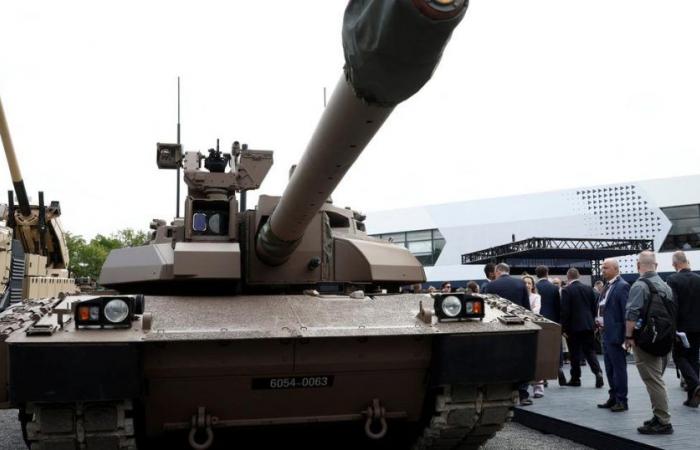INTERVIEW – The defense of France “stems from a Gaullian vision of an independent France having to rely on its own means,” recalls researcher Léo Péria-Peigné.
Léo Péria-Peigné is a researcher at the Center for Security Studies of the French Institute of International Relations (IFRI), and arms specialist. He publishes Geopolitics of armaments, instrument and reflections of international relations (The Blue RiderJune 2024).
LE FIGARO.- How is the Eurosatory show, which ends this Friday, representative of the geopolitics of armaments?
Léo PERIA-PEIGNE.- As the largest arms fair in the world, Eurosatory provides an interesting overview of the balances and developments in the world of arms. The nature of the systems exposed often says a lot about the evolution of current conflicts: relatively little present in the 2022 edition, anti-drone or jamming systems will be very present in 2024. Rheinmetall thus presents its turret Skyranger on four different vehicles to promote its versatility. Drones are even more present than two years ago, with increasing interest in suicide drones or long-range drones.
The size and placement of stands can also be studied: the stands closest to the main entrances are often those of companies with good results or promising new products. Already in 2022 and again here, Sig Sauer (one of the largest arms manufacturers in the world, Editor’s note)) showcases the US Army’s future assault rifles and light machine guns.
What is the particularity of French armaments geopolitics?
Paris is in a special position because it has long had a holistic industry that produced a full range of weaponry, from assault rifles to nuclear aircraft carriers. This choice stems from a Gaullian vision of an independent France having to rely on its own resources. However, our defense industrial and technological base (BITD) produces above all for France, taking into account its doctrine, its geopolitics and its needs before thinking about exporting.
Benoit Tessier / REUTERS
This BITD operates more in an arsenal than commercial logic and its most modern systems such as the Griffon, Serval and Jaguar vehicles are designed and developed in accordance with a French employment doctrine which remains unique. They will therefore be more difficult to export because other nations will have different expectations regarding expected performance and capabilities. Unlike Germany, whose army buys what its BITD produces. If the Bundeswehr (the German army, editor’s note) has a say on the equipment it buys and can request modifications, German industry designs its systems above all to be able to please potential customers.
How do you judge the state of the French BITD?
The French BITD is gradually emerging from several rather difficult decades after the end of the Cold War and the wave of privatization, which was accompanied by a significant reduction in budgets. This development has forced it to change its economic model, to become more involved in exports with less support from the State which orders less equipment than before. This transition was already quite well underway in the naval and air sectors with the successes of Naval Group and Dassault*.
The situation remains quite difficult in the terrestrial sector, but the two main groups, Arquus and KNDS France, seem to be on a positive path, better integrated into the global market and having succeeded in developing a few flagship products capable of supporting their efforts. Despite everything, the good results of our BITD are “doped” with the Rafale, which carries the commercial balance sheet of French arms on its shoulders: without the Rafale, France would probably not be second on the world arms market.
How does a defense industrial and technological base pose a sovereignty issue?
A State which has its own arms industry will be able to develop, produce and equip itself with weapons which will first respond to its own needs, to its own doctrine, to enable its armies to respond to the better to their objectives.
Read alsoGerman army chooses American F-35
Buying abroad implies a relative loss of autonomy: even if you benefit from technology transfers or partial production on your national territory, you most often remain dependent on your supplier for the most complex components and to higher added value. If the countries which buy American F-35 fighter bombers can claim to produce a more or less significant part of them, they remain dependent on the United States for the most advanced parts, but also for the essential software updates. In this situation, Washington could oppose military action carried out with these devices by threatening to cut off access to these updates or maintenance and force its partners to first respect its interests.
France, you write, has a strategy «bonzaï» of armament, that is to say to have a multiplicity of armaments but in small quantities. Is this relevant?
Military budgets, like manpower, were reduced at the end of the Cold War in most Western armies, which no longer had the means to maintain a holistic format. France, however, has chosen to maintain maximum capacity, even reduced to a minimum, in order to be able, if necessary, to increase its capacity. This strategy of «bonzaï» should, in theory, allow the small branches of the tree to grow if necessary. The French army has therefore retained tanks, heavy cannon and rocket artillery, amphibious capabilities, combat in mounts or in the Arctic environment, when other nations have chosen to specialize more to maintain a greater thickness but on a more limited range of capacities. The lessons of the war in Ukraine have shown the danger of such choices, pushing us to reacquire these essential capabilities for a high-intensity conflict.
This strategy of « bonzaï » should, in theory, allow the small branches of the tree to grow if necessary.
Léo Péria-Peigné
Choosing Bonzai also requires having time to revitalize a skill, but nothing is less certain in times of war! It is also based on the possession of nuclear weapons which must protect us from a high intensity threat. Our armies can therefore be used for various missions, such as expeditionary missions. This choice is not that of our partners and depends on a political choice. Do we want an army that protects us from a state threat like Russia or an army that does a little bit of everything? The question arises as the war continues in Ukraine.
The war in Nagorno-Karabakh showed the need for «dronisation» , that of Ukraine the interest of maintaining mass, and that of Gaza the usefulness of the infantryman. What do you remember about the tactical developments in these three conflicts?
The Nagorno-Karabakh conflict has shown the power of a drone ecosystem that combines Israeli lurking munitions, Turkish observation and combat drones, and handmade drone systems with old agricultural biplanes. Everyone interacted in a coherent and relevant manner. However, the conflict was very rapid and lasted only two weeks. Armenia therefore did not have time to develop a response that would have forced the Azeris to adapt. Conversely, in Ukraine, the Bayraktar TB2 drones, used in Nagorno-Karabakh, were put out of action very quickly because they did not meet the needs of this conflict.
The Russians have very good anti-aircraft and electronic warfare defenses. These drones were therefore not used and above all show the good capacity for adaptation of the two protagonists. We must nevertheless keep in mind that in Gaza as in Ukraine, the infantryman and artillery remain essential elements in the war. 80 to 90% of the dead and wounded, as well as the vehicles hit, are caused by conventional elements such as artillery and rocket launchers.
*The Dassault group owns Le Figaro






